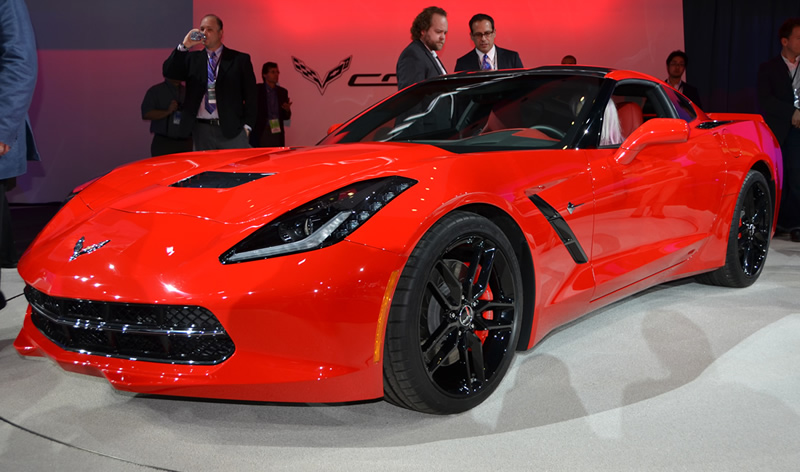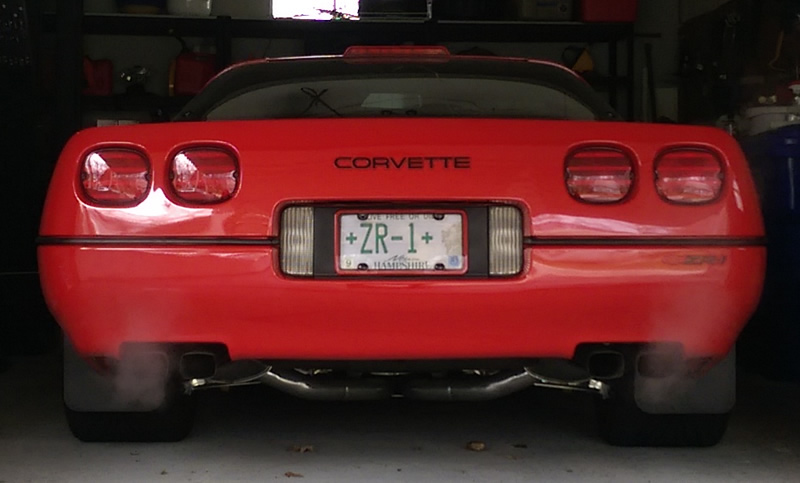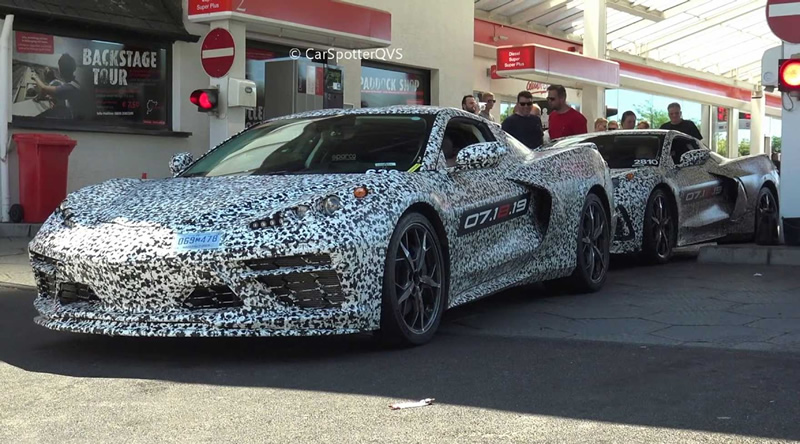With just a few weeks left until the 2020 mid-engine C8 Corvette is officially unveiled, YouTube blogger, CarSpotterQVS captured two 2020 C8 Corvettes making a pit stop for gas just outside of the Nürburgring race track.
This is one of the best videos we’ve seen thus far of the C8 prototypes. While these are raw prototypes meant just for testing, don’t expect the headlights and tail lights you see in the video to make it into production.
We do however, get to see the large front brake calipers up close for the first time as well as the interior of the car featuring an all digital instrument cluster. Gone is the mix of analog and digital instruments that we currently have in the C7 Corvette. The Sparco seats are not the production seats that we’ll see, however, it’s a pretty good assumption that competition seats will be an option just like they are with the C7 Corvette.
If you slow the video down, you can catch a very faint glimpse of the engine in the back through a see-through panel separating the cabin and engine compartment.
Upon take off, listen to the first C8. For a quick couple of seconds you can hear what almost sounds like supercharger whine. It’s quite possible that Corvette Engineers are testing both the base model engine, as well as a higher output engine slated for a Z06 model which we could see in 2021. The base model engine will more than likely be a second generation LT1 engine that currently powers the C7 Stingray and Grand Sport, however rumors also point to the possibility of a DOHC V8. Either way, both C8 prototypes sound awesome taking off from the gas station!
Planting The Seeds
There’s no doubt that the C7 Corvette was one of the most drastic changes we’ve ever seen in the Corvette’s history. The last time there was such a big change, was when the 1963 Corvette was unveiled. Since then, every generation of the Corvette has been an evolution and not as much of a revolution until the 2014 Corvette was unveiled at the North American International Auto Show in January of 2013.
Gone, were the rounded, smooth curves of the previous generations, replaced by stealth like edges and a much more aggressive, muscular stance. There was nothing else on the road that looked like it and to this day, there still is no other car on the road that looks like it. The C7 Corvette was so revolutionary in design, that it polarized a lot of long time Corvette enthusiasts. Fans seemed to either love it or hate it and over the years, a lot of the naysayers have slowly jumped the fence and come to appreciate the car.

One of GM’s main goals for the C7 Corvette was to attract younger buyers, and sway buyers away from the competition such as Porsche, who ordinarily, would never even consider a Corvette. For the most part, they succeeded, but failed at attracting younger buyers given the starting MSRP for the car. However, did they really fail at this?
One of the most important aspects of marketing is something I like to call “planting seeds”. Marketing isn’t all about rolling out a sale or new product one day, and selling a ton of them the next day. Marketing is also about attracting potential customers – future customers – customers that might not necessarily be ready to plunk down a large chunk of change on a new car, but the car is so stunning – you remember it. And each time you see one on the road, it sort of takes your breath away for a couple of seconds, and you suddenly feel that little tingle of lust. You keep those memories – the seeds in the back of your brain, until you finally reach that point in life where you’re able to make the move and buy the car that first touched your soul all those years ago.
Marketing isn’t just about instant sales – it’s about future sales as well. THIS is what GM *has* done with the C7 Corvette. GM has caught the eyes of the younger generations, and while those younger generations might not be in a position to buy a brand new C7 Corvette right now, they have planted the seeds and attracted future sales down the road.
What Can We Expect After the July 18, 2019 Unveiling?
As much as the C7 Corvette was revolutionary, expect the C8 Corvette to be even more so.
With all of the various technological patents we’ve seen GM file with the United States Patent and Trademark Office over the last couple of years, we can expect the C8 Corvette to be one of the most technologically advanced automobiles on the road at one-quarter to one-half the price of a brand new Ford GT.
The two biggest technological advancements that we’ll see is active aerodynamics and hybrid technology. We’ve already seen these technologies in production automobiles such as the Ford GT and the Ferrari LaFerrari, but the big difference here, is that GM will bring these technologies with advancements to market at half the cost if not less than the competition.
When the rumors started coming out that Corvette Engineers were working on a mid-engine Corvette and we first started seeing spy photos of it, a good chunk of the Corvette fan base instantly assumed it was going to start at $100,000 and they basically torched the C8 before a production based component of the car ever even touched the pavement.
What they failed to remember was that one of the most important ingredients that comes in every Corvette since 1953: do it as good, if not better than the competition, at half the price. To assume that GM would go from a front-engine to a mid-engine configuration and instantly double the starting MSRP of the car, was complete lunacy. It’s not what Corvette is or ever has been.
With that said – I would expect the base MSRP of the C8 Corvette to start approximately $5,000 – $7,000 more than the base MSRP of a 2019 C7 Stingray.
Two Big Questions Remain
The two main questions I always get asked are: “So there will be no more front-engine Corvettes?” and “Will it come with a manual transmission?”
While I have no inside knowledge, everything I’ve seen indicates that the front-engine configuration ends with the C7 and there will be no manual transmission – both of which, are much to my dismay.
One of the things I’ve always wanted to see is GM expand the Corvette lineup and follow more of a business model like Ferrari.
Ferrari sells both front-engine and mid-engine cars. The mid-engine cars have usually always been the high performance, ultra-technologically advanced models at stratospheric prices. The front-engine Ferraris have always been more of the entry level models. It’s my unprofessional belief that there is a market for both in the Corvette customer base.
As for the manual transmission, this is probably one of my biggest disappointments.
There’s no doubt that automatic transmissions and dual clutch transmissions can shift at lightning speeds – faster than any human being ever could, but not every customer places such a high degree of importance on 0-60 and quarter mile times.
As many of our readers know, I own a 1990 Corvette ZR-1 that I’ve had since 1994. While the C4 generation has its quirks, I’m still in love with the ole girl, and one of the reasons why, is the ZF 6-speed manual transmission. It doesn’t have the wonderful joystick feel of the 7-speed manual in a C7, and you practically have to be a bodybuilder to work the clutch, but there is just nothing like taking that Corvette out on the open road and rowing through the gears. There is a connection that is established between man and machine when you are the one in control of rowing through the gears – downshifting and upshifting. It’s a connection that you just don’t get with an automatic transmission or flicking paddles on a steering wheel.

I understand that the majority of Corvettes and most sports cars, are now sold with automatic transmissions, but it saddens me. It saddens me because younger generations of drivers have no clue what their missing out on. They have no clue what to do with a manual transmission, and that is disappointing when it comes to the art of true, spirited driving.
Regardless, it’s my opinion that this next generation, mid-engine Corvette is going to be nothing short of amazing, and I’m truly excited to see what the future holds for the marque!

